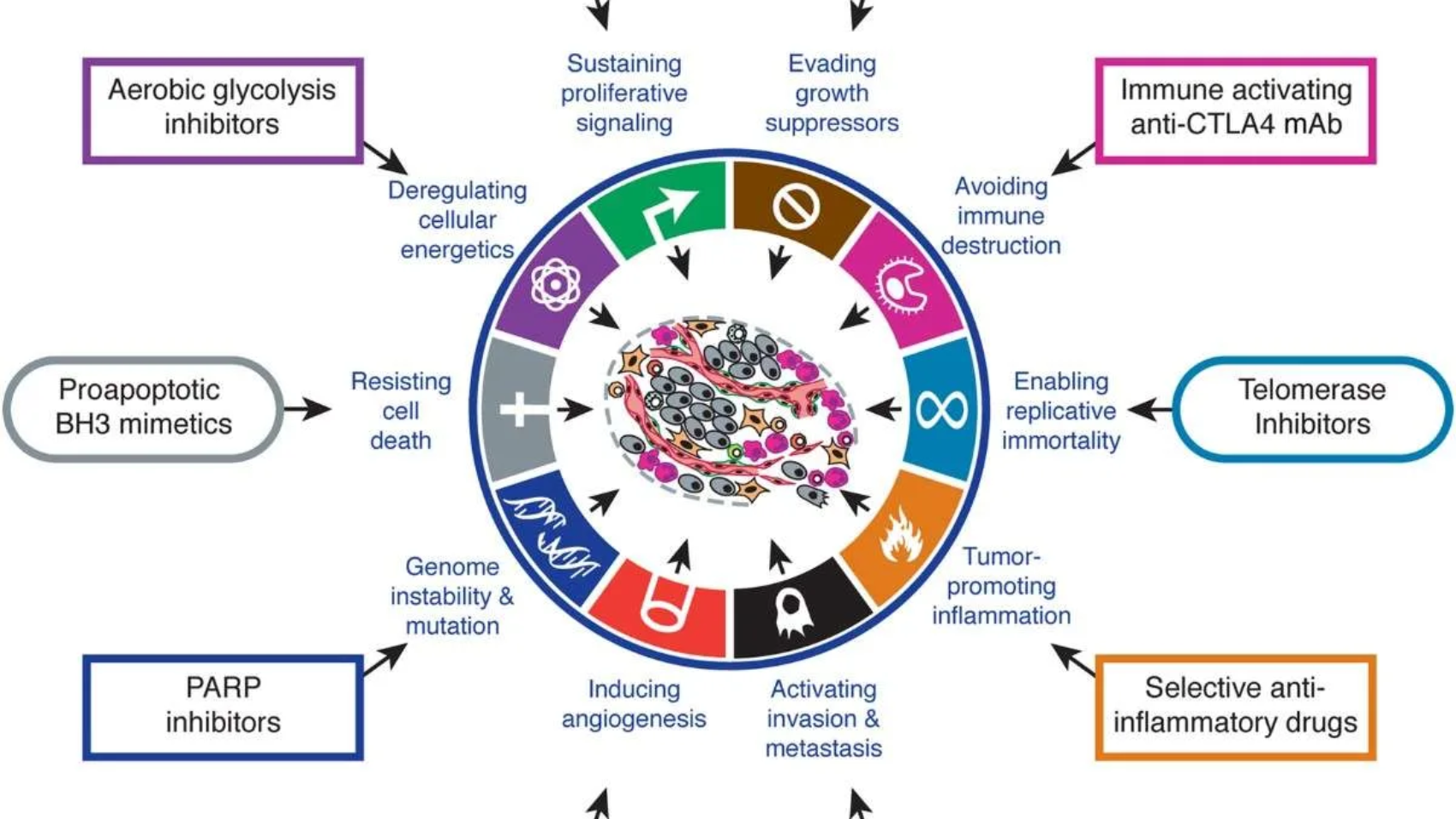Abtract
Cancer is a complex group of diseases marked by uncontrolled cell growth and the capacity to invade or spread to other parts of the body. Advances in understanding the biological behavior of cancer cells have been significant over the past few decades, driven largely by the identification of specific characteristics—or “hallmarks”—that define the transformation of normal cells into malignant ones. This article reviews the concept of the hallmarks of cancer as proposed by Hanahan and Weinberg, and explores how these traits contribute to the development and progression of tumors.
Introduction
Cancer remains one of the leading causes of morbidity and mortality worldwide. It develops due to a combination of genetic and epigenetic changes that disrupt normal cellular processes. In 2000, Douglas Hanahan and Robert A. Weinberg introduced a landmark framework titled “The Hallmarks of Cancer“, which sought to simplify the understanding of cancer’s complexity. This framework was updated in 2011 and further expanded in 2022, offering a comprehensive model that describes the functional capabilities cancer cells acquire during tumorigenesis.
HALLMARK CAPABILITIES—CONCEPTUAL PROGRESS
The six hallmarks of cancer—distinctive and complementary capabilities that enable tumor growth and metastatic dissemination—continue to serve as a solid foundation for understanding the biology of cancer. In the first section of this review, we summarize the essence of each hallmark as originally described in 2000, followed by select illustrations of the conceptual progress made over the past decade in elucidating their mechanistic underpinnings.
In subsequent sections, we address new developments that broaden the scope of this conceptualization, describing in turn:
- Two enabling characteristics that are crucial for the acquisition of the six hallmark capabilities,
- Two newly emerging hallmark capabilities,
- The composition and signaling interactions of the tumor microenvironment, which are essential to cancer phenotypes,
- And finally, we discuss the new frontier of therapeutic applications that leverage these concepts.
The Hallmarks of Cancer (2000, 2011, 2022)
Originally, six core hallmarks of cancer were identified in 2000. In 2011, two emerging hallmarks and enabling characteristics were added to the framework. More recently, additional hallmarks have been proposed to reflect new discoveries and insights in cancer research.
Core Hallmarks (2000)
- Sustaining Proliferative Signaling : Cancer cells acquire the ability to continuously stimulate their own growth or signal their environment to support constant cell division. This allows them to bypass normal growth-control mechanisms that typically regulate cell proliferation.
- Evading Growth Suppressors : Tumor cells develop mechanisms to bypass the regulatory effects of tumor suppressor genes, such as p53 and Rb, which normally act to restrict cell growth and division. By disabling these crucial brakes on proliferation, cancer cells gain a growth advantage.
- Resisting Cell Death (Apoptosis) : Cancer cells develop strategies to evade apoptosis, the body’s natural process of programmed cell death. This allows abnormal and damaged cells to survive and proliferate despite genetic or environmental stressors.
- Enabling Replicative Immortality : Cancer cells sustain their capacity to divide indefinitely by activating the enzyme telomerase, which maintains telomere length. This bypasses the normal cellular aging process and allows for continuous proliferation.
- Inducing Angiogenesis : Tumours stimulate the formation of new blood vessels (angiogenesis) to secure a continuous supply of oxygen and nutrients, which is essential for their growth and survival.
- Activating Invasion and Metastasis : Cancer cells acquire the ability to invade neighbouring tissues and spread to distant organs, leading to the formation of secondary tumours (metastases).
Emerging Hallmarks (2011)
- Deregulating Cellular Energetics: Cancer cells reprogram their energy metabolism, often favoring glycolysis even in the presence of oxygen (the Warburg effect), to support rapid growth and proliferation.
- Avoiding Immune Destruction : Tumors evolve strategies to evade immune surveillance, suppress immune responses, and avoid elimination by the body’s defense mechanisms, allowing cancer cells to survive and proliferate.
Enabling Characteristics (2011)
- Genome Instability and Mutation : Increased mutation rates provide a pool of genetic variations for cancer progression.
- Avoiding Immune Destruction : Tumours develop mechanisms to evade detection and destruction by the immune system.
Enabling Characteristics (2011)
- Genome Instability and Mutation : Increased mutation rates provide a pool of genetic variations for cancer progression.
- Tumour-Promoting Inflammation : Tumors evolve strategies to evade immune surveillance, suppress immune responses, and avoid elimination by the body’s defense mechanisms, allowing cancer cells to survive and proliferate.
Evading Growth Suppressor
Circumventing Tumour Suppressor Gene Programs in Cancer
Cancer cells must not only sustain growth-promoting signals but also evade the powerful negative regulators of cell proliferation—primarily tumour suppressor genes. Dozens of tumour suppressors, identified through their inactivation in various cancers, limit cell growth and proliferation. Two of the most critical tumour suppressors are RB (retinoblastoma-associated protein) and TP53 (p53 protein), which act as central regulators controlling whether cells proliferate, enter senescence, or undergo apoptosis.
- RB Protein : Acts as a gatekeeper of the cell cycle by integrating signals from both inside and outside the cell. When functional, RB prevents inappropriate cell cycle progression. Cancer cells with defective RB pathways lose this control, allowing continuous proliferation.
- TP53 Protein : Acts as a sensor of cellular stress and damage. It halts cell cycle progression in response to DNA damage, nutrient deprivation, or other stressors, and can initiate apoptosis if the damage is irreparable. TP53’s effects are complex and context-dependent, varying with cell type and the severity of stress.
Both RB and TP53 operate within larger, functionally redundant networks. For example:
- Mice engineered with RB-deficient cells surprisingly show few proliferation defects and normal tissue development, with tumours appearing only late in specific tissues (e.g., pituitary).
- TP53-null mice develop normally but tend to develop cancers like leukemia and sarcomas later in life.
Newly Proposed Hallmarks (2022)
Recent research has added more complexity to the cancer framework. Proposed new hallmarks
include:
- Unlocking phenotypic plasticity
- Non-mutational epigenetic reprogramming
- Polymorphic microbiomes influencing cancer
- Senescent cells promoting tumour growth
Application
- Provides a structured, simplified model to study Cancer progression.
- Guiding Cancer Research.
- Basis for developing Targeted therapies.
- Personalizing Cancer treatment.
- Predicting treatment response and prognosis.
- Designing Diagnostic and Prognostic biomarkers.
- Drug Development and Clinical trials.
- Integrating Multi Disciplinary approaches.
Future Vision
- Discovery of New Hallmarks.
- Integration with Precision and Personalized Medicine.
- Multi-Targeted Therapies.
- Application in Early Detection and Prevention.
- AI and Computational biology integration.
- Hallmarks and Immuno-oncology.
- Focus on Cancer Heterogeneity and Plasticity.
Conclusion
The Hallmarks of Cancer framework offers a robust way to understand the complexity of tumour biology. It has been instrumental in guiding the development of new therapies aimed at targeting these hallmark traits. As research progresses, the model evolves to include emerging insights into tumour behavior, immune system evasion, altered metabolism, and interactions with the tumour microenvironment.

Author Name
Yewale Saloni Ravindra

